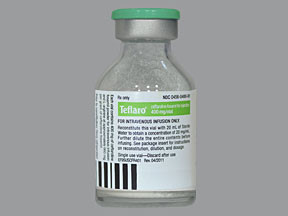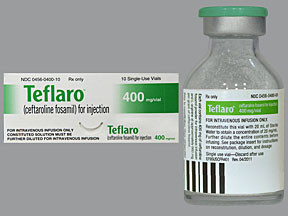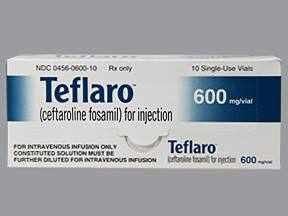CEFTAROLINE - INJECTION
PHONETIC PRONUNCIATION: (sef-TAR-oh-leen)
COMMON BRAND NAME(S): Teflaro
GENERIC NAME(S): ceftaroline fosamil acetate
Uses
USES: Ceftaroline is an antibiotic used to treat a variety of bacterial infections. This medication is known as a cephalosporin antibiotic. It works by stopping the growth of bacteria.
How to use CEFTAROLINE - INJECTION
HOW TO USE: This medication is given by injection into a vein as directed by your doctor, usually every 8 or 12 hours. The dosage is based on your medical condition and response to treatment. In children, the dosage is also based on age and weight. If you are using this medication at home, learn all preparation and usage instructions from your health care professional. Before using, check the product visually for particles or discoloration. If either is present, do not use the liquid. Learn how to store and discard medical supplies safely. For the best effect, use this antibiotic at evenly spaced times. To help you remember, use this medication at the same time(s) every day. Continue to use this medication until the full prescribed treatment period is finished, even if symptoms disappear after a few days. Stopping the medication too early may allow bacteria to continue to grow, which may result in a return of the infection. Tell your doctor if your condition persists or worsens.
Side Effects
Precautions
Interactions
Overdose
Images
Reviews
Faq for CEFTAROLINE - INJECTION
Ceftaroline injection is used to treat bacterial infections, including skin and skin structure infections and community-acquired pneumonia.
Ceftaroline works by stopping the growth of bacteria that cause infections, by interfering with their cell wall synthesis.
Common side effects of ceftaroline injection may include diarrhea, nausea, headache, or redness/pain at the injection site.
Ceftaroline injection is administered by a healthcare professional through intravenous (IV) infusion.
If you miss a dose of ceftaroline injection, contact your healthcare provider to schedule a new appointment for the missed dose.
It is generally recommended to avoid drinking alcohol while receiving ceftaroline injection, as it may increase the risk of side effects and reduce the effectiveness of the medication.
Ceftaroline injection should be used during pregnancy only if clearly needed. It is not known if ceftaroline passes into breast milk, so it is advisable to consult with a doctor before breastfeeding while receiving ceftaroline.
The exact time for ceftaroline injection to start working may vary depending on the individual and the specific infection. It is important to continue the full course of treatment as prescribed by your healthcare provider.
Ceftaroline injection may interact with certain medications, so it is important to inform your healthcare provider about all the medications and supplements you are currently taking.
Disclaimer
IMPORTANT: HOW TO USE THIS INFORMATION: This is a summary and does NOT have all possible information about this product. This information does not assure that this product is safe, effective, or appropriate for you. This information is not individual medical advice and does not substitute for the advice of your health care professional. Always ask your health care professional for complete information about this product and your specific health needs.




No Reviews Yet